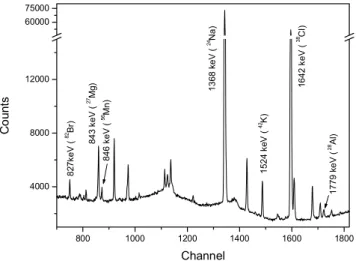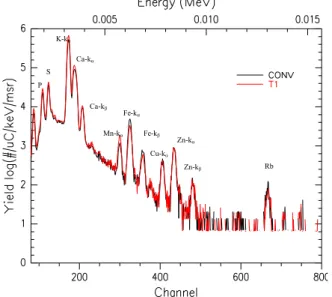814 Brazilian Journal of Physics, vol. 35, no. 3B, September, 2005
Multielemental Analysis of Genetically Modified Food using
ANAA and PIXE Techniques
Ilca Marli Moitinho Amaral Medeiros, Cibele Bugno Zamboni, Jos´e Agostinho Gonc¸alves de Medeiros, Instituto de Pesquisas Energ´eticas e Nucleares, Caixa Postal 11049, 05422-970, S ˜ao Paulo, SP, Brazil
Marcia de Almeida Rizzutto, Nemitala Added, and Manfredo Harri Tabacniks Instituto de F´ısica da Universidade de S˜ao Paulo, Caixa Postal 66318, 05315-970, S ˜ao Paulo, SP, Brazil
Received on 12 August, 2005
This paper describes the application of two techniques, ANAA and PIXE, used in the analyses of some availa-ble commercial food containing regular and genetically modified ingredients, as well as soybens cultivated with regular and genetically modified seeds (GMS). The aim of this work is determine their elemental composition to perform a comparative analysis. The elemental composition results of both types of food, obtained by the two techniques, were in agreement for all elements. Our results show the same elemental composition for all food samples but the quantitative analysis between soybeans seeds (regular and GM) suggested that the product made with GMS have higher concentration values, mainly for Cl, P and Zn, while for industrialized food, made with genetically modified products, a low concentration values were measured for most of the elements.
I. INTRODUCTION
The importance of essential elements to human health has stimulated the analysis of their occurrence in a wide variety of foodstuffs. In the early 80’s, the first experiment involving the transgenic vegetables gave rise to the research on gene-tically modified food (GMF) production. Since then, some benefits in cellular biology as well as in agriculture were ob-tained. The knowledge obtained permits production of vege-tables with modified quantities of lipids and proteins in se-eds, virus and plagues resistance and also allows cultivation on salty soils and swamps. According to recent statistics, about 60% of world population consumes GMF and almost 22 million acres are cultivated with transgenic species in the world. Particularly, the analysis related to GMF consumed by the Brazilian population is important due to an increase in its consumption. Considering the increasing demand of GMF and the new developments related to its world produc-tion, in the beginning of the 90’s the Organization for Econo-mic Cooperation and Development [1] established the concept of substantial equivalence [2, 3] to be used as a guide for safe evaluation of GMF. Since then, this guide has been implemen-ted by the Food and Agriculture Organization [3–5], together with many other regulatory agencies in several countries, in-cluding the European Commission. The purpose of this study is to check the elemental composition of food containing ge-netically modified ingredients as well as soybeans cultivated with regular and GMS to perform a comparative analyses, al-lowing to verify if there are significant modifications in their elemental composition.
II. EXPERIMENTAL PROCEDURE
To perform these measurements several brands of potato chips made with conventional and genetically modified po-tatoes, which are consumed by the local population, were bought in supermarkets at S˜ao Paulo city while the soybeans
were obtained from plantation where regular and GMS are cultivated. All analyses were performed by mixing and ho-mogenizing each sample obtaining appropriate granules. The ANAA analyses was performed in the IEA Reactor at IPEN facility while the PIXE analysis was performed in the LAMFI (Ion Beam Material Analysis Laboratory) at USP facility.
To identify and determine the element’s concentration of elements present in the samples, by using ANAA technique, approximately 50mg of samples were weighed and sealed in the polyethylene bags. The samples were irradiated in the IEA-R1 nuclear reactor at IPEN, by a thermal neutron flux of 5 x 1011n/cm2s during 5 minutes, using a pneumatic system, in order to identify short half life isotopes. For the analyses of the long half life isotopes the samples were irradiated for 3 hours in the central core in a flux of 1012n/cm2s. The neutron flux was measured with the Cadmium Ratio Technique [6] and the samples were analyzed with HPGe gamma-spectrometer with high resolution Ge detector (FWHM≤1.87 keV at 1.32 MeV of60Co) mounted inside a lead shield hood in order to reduce the background radiation. The detector was operated with 671 ORTEC amplifier, in pile-up rejection mode to re-duce the secondary detection effects, besides samples with low activity were produced (≤1µCi) to minimize mainly the Compton scattering. The concentration value of each element were performed using computer code [7]. Typical gamma-ray spectrum obtained by ANAA are shown in figures 1 and 2. All the analyses were performed with the correction of the background contribution. An example of the soybeans spec-trum and the corresponding background contamination in the energy region of Fe and Ni is shown in figure 3.
In the analysis performed by PIXE technique [8] the mea-surements were performed at the LAMFI using a 2.4MeV pro-ton beam to generate characteristic X-rays of the samples. The powdered samples (10%) were mixed with a powdered of Bo-ric Acid (HBO3) (90%) and compressed (4 tons) into pellets of
Ilca Marli Moitinho Amaral Medeiros et al. 815
FIG. 1: Partialγ-ray spectrum of potatoes chips GM for short time irradiation (peaks without energy indication are natural background, time counting 2 hour).
FIG. 2: Partialγ-ray spectrum of soybeans cultivated in the conventi-onal way for short time irradiation (peaks without energy indication are natural background, time counting 2 hour).
each sample. The X-rays were monitored with a Si(Li) detec-tor (FWHM resolution of about 145 eV @MnKα) located at an angle of 135◦with respect to the incident beam. A plain thick Mylar absorber (30µm ) was used to avoid the detec-tion of back-scattering protons, and a ”funny filter” made of a 300µm thick Mylar with 0.1mm hole was used to equalize the detection yield and reduce low energy rays pile up. The X-ray spectra were analyzed using the AXIL analysis software [9]. To determine the concentration of a thick target sample we used a matrix standardization in which the powdered sam-ple is diluted to a few percent (10%) in a known matrix made of ”light” elements (e.g. Boric Acid). At low concentrati-ons, the energy loss and X-ray absorption coefficients in the matrix can be kept almost unchanged. At the same time, the tt-PIXE yields can be calculated by simply applying a thick target correction factor to the already known thin target PIXE yields. The thick target correction factors were obtained with
FIG. 3: Partialγ-ray spectrum of soybeans compared with the back-ground (time counting 30 minutes).
a new computer program CLARA [10] which evaluates the integral of thick target. The corrections factors were calcula-ted for boric acid (HBO3H2O) matrix which allow determine
the elemental concentration (inµgg−1) for these thick
sam-ples.Typical X-ray spectrum are show in figures 4 and 5.
III. RESULTS AND DISCUSSION
Four conventional and genetically modified brands of po-tato chips samples were investigated. To illustrate the results related to potatoes chips (regular and GMF) one brand of each one are presented in Table I. Related to the soybeans seeds the analyses were performed in four soybeans regular seeds and in three GMS. To illustrate the results one of each species are shown in Table II.
816 Brazilian Journal of Physics, vol. 35, no. 3B, September, 2005
FIG. 4: Typical X-ray spectrum of potatoes chips where C3 is regular sample and D3 is GM sample.
FIG. 5: Typical X-ray spectrum soybeans cultivated with regular (CONV) and GM (T1) seeds.
IV. CONCLUSION
This experiment allowed the identification of several ele-ments in some conventional and genetically modified pro-ducts, available commercially, by using Absolute Neutron Ac-tivation Analysis (ANAA) and Particle Induced X-Ray Emis-sion (PIXE) techniques. The results show the same elemental composition for all food samples (Br, Ca, Cl, Cr, Fe, K, Mg, Mn, Na, Ni, P, Rb, S and Zn) but the comparative analysis suggested that products genetically modified have higher con-centration values for the majority of the elements (Br, Ca, Cl, Cr, Mn, K, P, S and Zn) and for the other are constant (Cu, Fe, Mg, Rb and Na) when the comparison is performed with the seeds (soybeans) where no industrial process is involved.
PIXE ANAA PIXE ANAA
Element Regular GMF
µgg−1 µgg−1
P 955(39) nd 1097(222) nd S 2159(32) nd 2039(71) nd Cl 4229(37) 3920(10) 6648(79) 6639(122) K 12112(84) 11921(257) 6172(55) 7702(26) Ca 104(5) 100(14) 192(13) 221(31) Cr 7.6(9) 8.1(6) 10.5(20) 9.8(7) Mn 7.4(8) 6.9(7) 4.5(16) 5.3(12)
Fe 60.5(12) 66.0(27) 73.7(26) 80.0(41) Ni 2.5(6) 3.1(2) 2.2(11) 1.9(2)
Al no nd no nd
Mg no 11.6(9) no 7.1(7)
Na no 32100(18) no 22900(22) Cu 5.6(7) 6.5(4) 1.3(12) 1.5(1) Zn 17.1(9) 17.3(14) 2.4(13) 3.0(2) Br 12.3(31) 13.1(10) nd 14.8(6)
Rb 20.7(52) no no no
no: element not observed
nd: element observed but not determined
TABLE I: The element’s concentration in foodstuffs (potato chips) made with regular and genetically modified potatoes obtained by PIXE and ANAA.
PIXE ANAA PIXE ANAA
Element Regular GMS
µgg−1 µgg−1
P 1672(328) nd 5139(379) nd S 2109(141) nd 4462(152) nd Cl 168(74) 142(11) 649(68) 639(22)
K 8557(101) 7810(274) 19447(178) 17994(341) Ca 736(30) 681(81) 1113(35) 1021(134) Cr 6.6(36) 7.8(7) 11.2(36) 10.8(7) Mn 16.4(34) 14.2(5) 32.9(38) 27.6(28)
Fe 106.3(55) 99.6(55) 102.4(52) 98.7(41) Ni 9.8(25) 8.5(6) 5.2(21) 4.9(4)
Al no nd no nd
Mg no 5.6(5) no 4.5(4)
Na no 580(17) no 571(15)
Cu 7.4(28) 8.4(8) 7.0(26) 5.5(5) Zn 10.8(34) 12.4(14) 38.8(49) 32.7(22) Br 1.16(17) 1.01(10) 2.01(53) 1.68(17) Rb 12.9(5) no 15.4(14) nd no: element not observed
nd: element observed but not determined
TABLE II: The Concentration of the elements in soybeans cultivated of regular and with GMS.
nutri-Ilca Marli Moitinho Amaral Medeiros et al. 817
tional information considering that GMS show high concen-tration values, mainly in the majority elements.
Acknowledgments
The authors thank to FAPESP and CNPq for financial sup-port.
[1] Tech. Rep., Organisation for Economic Co-operation and Development - OECD, Paris (2002), available in http://www.oecd.org/dataoecd/57/3/1946129.pdf.
[2] Application of the principles of substancial equivalence to the safety evaluation of food and food components from plants derived by modern biotechnology, Food and Agricul-ture Organization of the United Nations/World Health Or-ganization (FAO/WHO) (Report of a WHO - Workshop (WHO/FNU/FOS/95.1), Geneva, 1995).
[3] Food and A. O. of the United Nations/World He-alth Organization (FAO/WHO), report of a Joint FAO/WHO Expert Consultation on Food Derived from Biotechnology, Geneva (2000), available in http://www.euro.who.int/document/fos/biotechrep72000.pdf. [4] Biotechnology and food safety. Report of a Joint FAO/WHO
Consultation, (FAO Food Nutrition Paper, 61, 31 p.) (Food and Agriculture Organization of the United Nations/World Health
Organization (FAO/WHO), Rome, 1996).
[5] Food and A. O. of the United Nations/World Health Organiza-tion (FAO/WHO), Tech. Rep., Yokohama, Japan (2002), avai-lable in ftp://ftp.fao.org/codex/Alinorm03/al03 34e.pdf. [6] U. D. Bitelli, Master’s thesis, Instituto de Pesquisas Energ´eticas
e Nucleares - IPEN/SP, Brazil (1988).
[7] J. A. G. Medeiros (2003),Private Communication, Laborat´orio de Estrutura Nuclear - Instituto de Pesquisas Energ´eticas e Nu-cleares - LEN/IPEN.
[8] S. A. E. Johansson and J. L. Campbell,PIXE: A novel technique for elemental analysis(John Wiley&Sons, Inc., 1988). [9] P. V. Espen, H. Nullens, and F. Adams, Nucl. Instr.and Meth.
145, 579 (1977).

